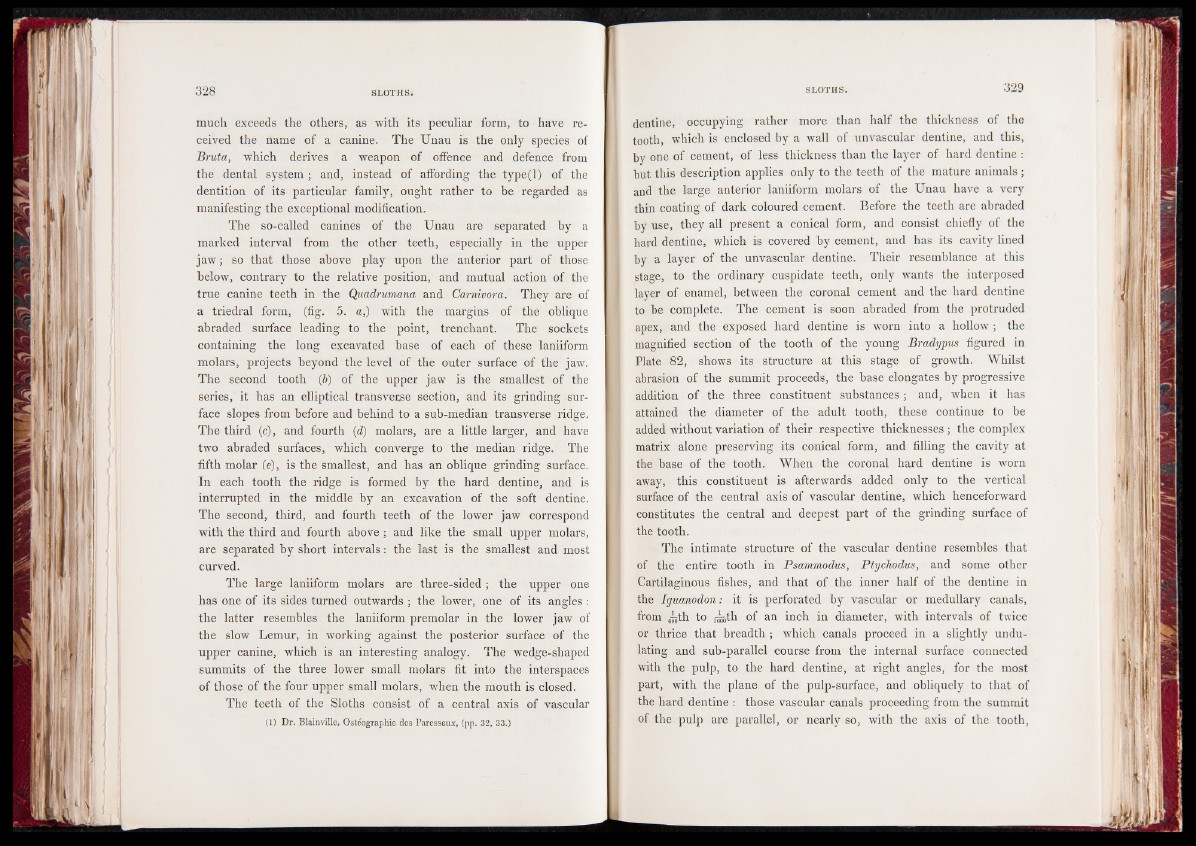
much exceeds the others, as with its peculiar form, to have received
the name of a canine. The Unau is the only species of
Bruta, which derives a weapon of offence and defence from
the dental system ; and, instead of affording the type(l) of the
dentition of its particular family, ought rather to he regarded as
manifesting the exceptional modification.
The so-called canines of the Unau are separated by a
marked interval from the other teeth, especially in the upper
jaw; so that those above play upon the anterior part of those
below, contrary to the relative position, and mutual action of the
true canine teeth in the Quadrumana and Carnivora. They are of
a triedral form, (fig. 5. a,) with the margins of the oblique
abraded surface leading to the point, trenchant. The sockets
containing the long excavated base of each of these laniiform
molars, projects beyond the level of the outer surface of the jaw.
The second tooth (6) of the upper jaw is the smallest of the
series, it has an elliptical transverse section, and its grinding surface
slopes from before and behind to a sub-median transverse ridge.
The third (c), and fourth (d) molars, are a little larger, and have
two abraded surfaces, which converge to the median ridge. The
fifth molar (e), is the smallest, and has an oblique grinding surface.
In each tooth the ridge is formed by the hard dentine, and is
interrupted in the middle by an excavation of the soft dentine.
The second, third, and fourth teeth of the lower jaw correspond
with the third and fourth above ; and like the small upper molars,
are separated by short intervals: the last is the smallest and most
curved.
The large laniiform molars are three-sided; the upper one
has one of its sides turned outwards ; the lower, one of its angles :
the latter resembles the laniiform premolar in the lower jaw of
the slow Lemur, in working against the posterior surface of the
upper canine, which is an interesting analogy. The wedge-shaped
summits of the three lower small molars fit into the interspaces
of those of the four upper small molars, when the mouth is closed.
The teeth of the Sloths consist of a central axis of vascular
(1) Dr. Blainville, Osteographie des Paresseux, (pp. 32, 33.)
dentine, occupying rather more than half the thickness of the
tooth, which is enclosed by a wall of unvascular dentine, and this,
by one of cement, of less thickness than the layer of hard dentine :
but this description applies only to the teeth of the mature animals;
and the large anterior laniiform molars of the Unau have a very
thin coating of dark coloured cement. Before the teeth are abraded
by use, they all present a conical form, and consist chiefly of the
hard dentine, which is covered by cement, and has its cavity lined
by a layer of the unvascular dentine. Their resemblance at this
stage, to the ordinary cuspidate teeth, only wants the interposed
layer of enamel, between the coronal cement and the hard dentine
to be complete. The cement is soon abraded from the protruded
apex, and the exposed hard dentine is worn into a hollow; the
magnified section of the tooth of the young Bradypus figured in
Plate 82, shows its structure at this stage of growth. Whilst
abrasion of the summit proceeds, the base elongates by progressive
addition of the three constituent substances ; and, when it has
attained the diameter of the adult tooth, these continue to be
added without variation of their respective thicknesses ; the complex
matrix alone preserving its conical form, and filling the cavity at
the base of the tooth. When the coronal hard dentine is worn
away, this constituent is afterwards added only to the vertical
surface of the central axis of vascular dentine, which henceforward
constitutes the central and deepest part of the grinding surface of
the tooth.
The intimate structure of the vascular dentine resembles that
of the entire tooth in Psammodus, Ptychodus, and some other
Cartilaginous fishes, and that of the inner half of the dentine in
the Iguanodon: it is perforated by vascular or medullary canals,
from jjjth to j^th of an inch in diameter, with intervals of twice
or thrice that breadth ; which canals proceed in a slightly undulating
and sub-parallel course from the internal surface connected
with the pulp, to the hard dentine, at right angles, for the most
part, with the plane of the pulp-surface, and obliquely to that of
the hard dentine : those vascular canals proceeding from the summit
of the pulp are parallel, or nearly so, with the axis of the tooth,